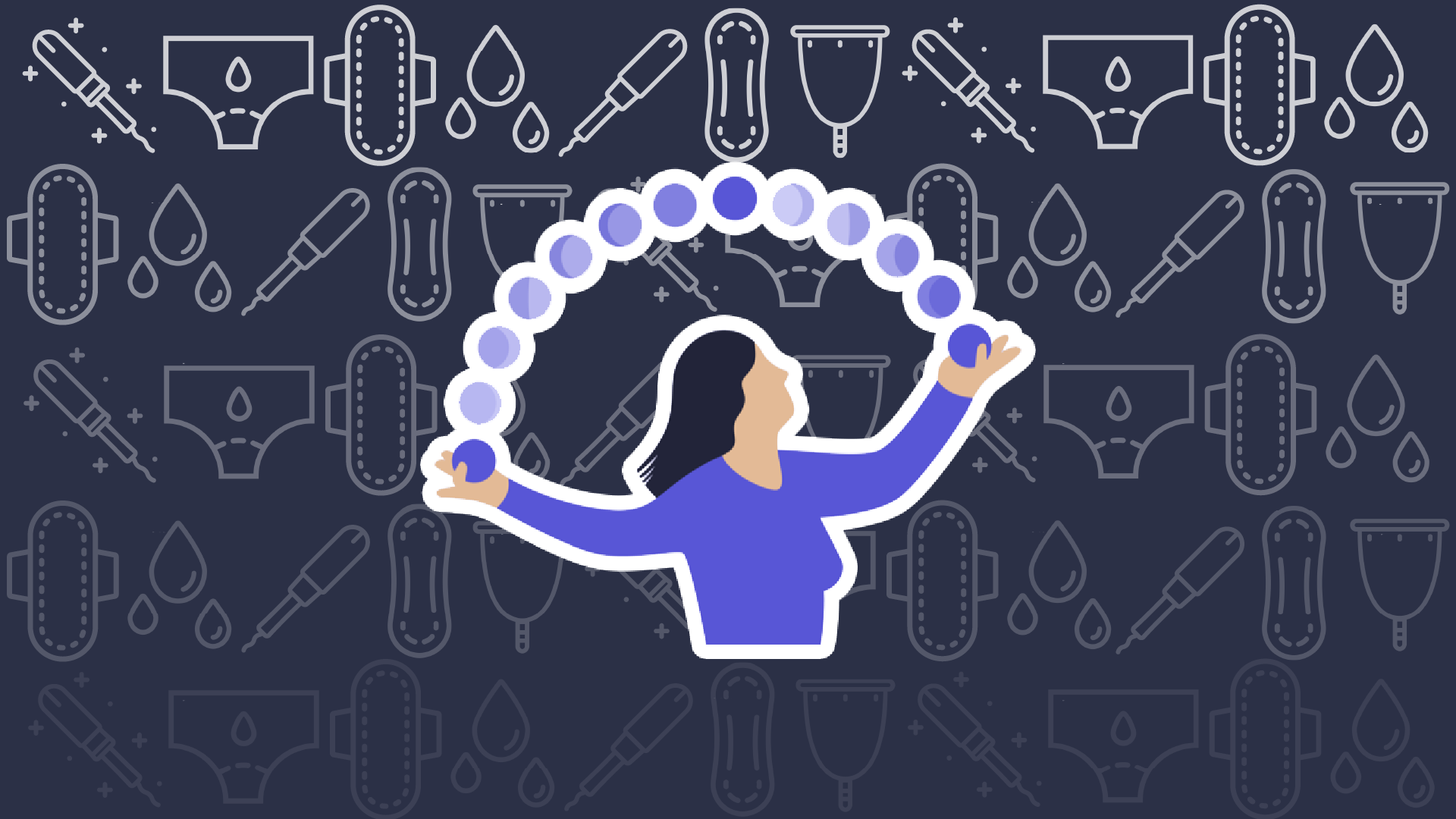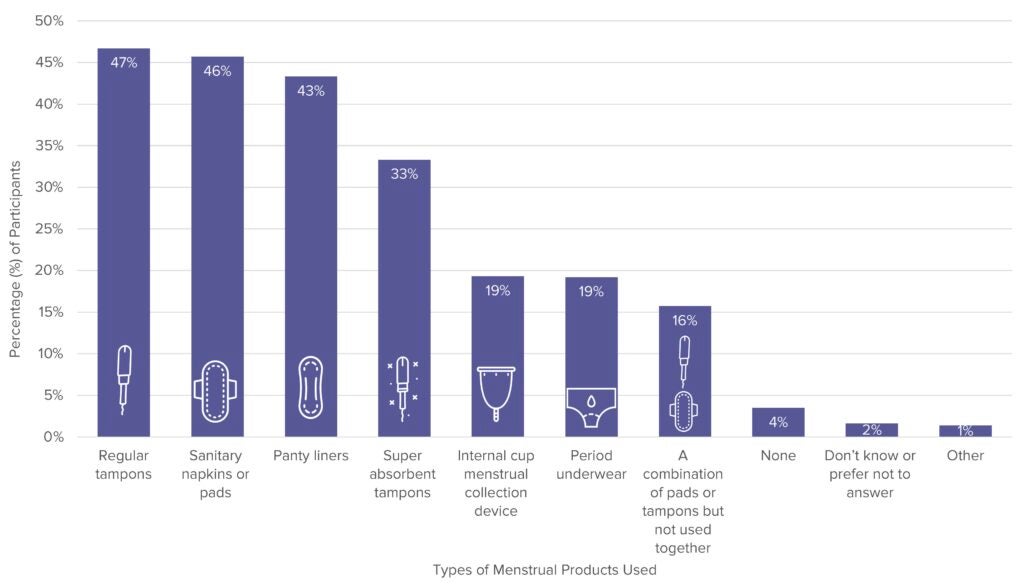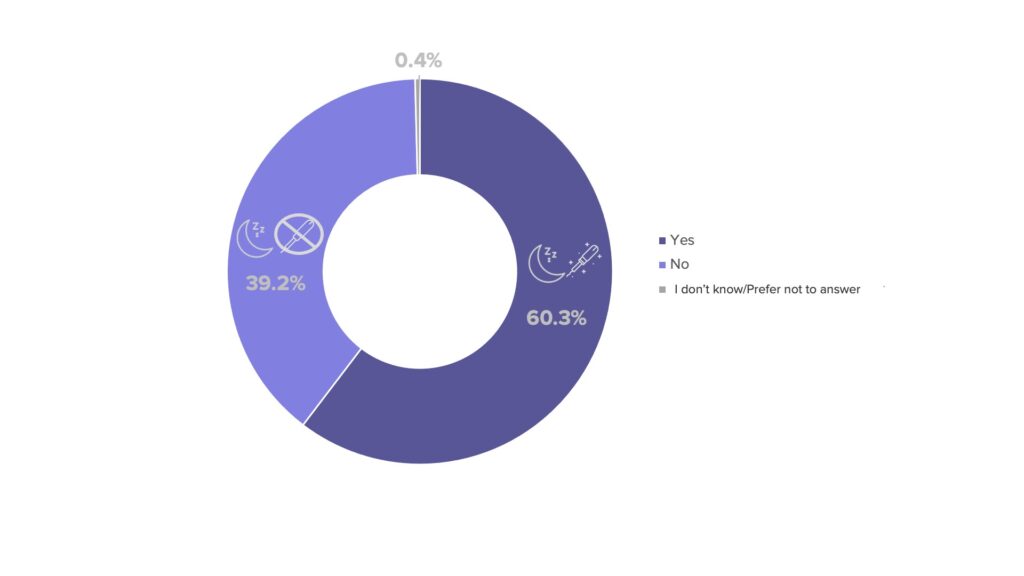
MAY 2023: No matter how different menstrual cycles might be, people with periods can often choose which menstrual products they use each month. The types of menstrual products we have access to determine our quality of life – our health, the ability to attend school, work productively, and how we feel. How people choose menstrual products is one critical chapter of the menstrual health story.
The Apple Women’s Health Study (AWHS) collects data on menstruation and menstrual cycles to better understand the health of women and everyone who menstruates. The study aims to elevate the menstrual cycle as a vital sign – a key indicator for overall health1.
In anticipation of Menstrual Hygiene Day on May 28th, a day celebrating menstrual health and hygiene globally, the AWHS research team explored which products people most commonly use for their periods.
Our key findings are that:
- People use a variety of menstrual hygiene products.
- The four most commonly-used menstrual hygiene products are regular tampons, sanitary napkins or pads, panty liners, and super-absorbent tampons.
- A smaller number of participants use an internal menstrual cup or period underwear.
- Some study respondents use a combination of pads and tampons during their cycle, though they did not report using the products simultaneously.
Please note the data reported below are descriptive data presented as frequencies both overall and in specific subgroups of respondents. These initial descriptive trends will be subject to formal statistical analysis in future work.
How we asked about period product use
Researchers analyzed the data of the 7,394 participants in the AWHS. All participants were still menstruating (pre-menopausal) and answered questions about their age, pregnancy history, and menstrual hygiene product choices.
The question was “What kind of menstrual hygiene products do you typically use?” and the participants were provided a list of answers from which they could choose all responses that applied. The answer choices were:
- Panty liners
- Sanitary napkins or pads
- Regular tampons
- Super-absorbent tampons
- A combination of pads or tampons but not used together.
- Period underwear
- Menstrual cup
Participants were also offered the options “other,” “none,” and “don’t know or prefer not to answer.”
For people who selected either regular or super-absorbent tampons, they were asked a follow-up yes-or-no question about whether they slept with a tampon in place, “Do you typically sleep with a tampon in place at night during your period?” with the options of “don’t know” or “prefer not to answer” offered as well.
Researchers began asking these questions in the annually distributed Cycle Tracking Survey in November 2022. It will take a full year for all participants to receive the new survey questions. All participants will be able to update their responses to the survey questions on an annual basis.
Traditional products are the most popular, but younger people are trying newer options
The most commonly-used products were those that have been on the market for many decades: pads and tampons.
A summary of menstrual product use among our participants is illustrated in the graph below.

Nearly half, 47%, of respondents reported using regular tampons, which are placed within the vagina. A close second, sanitary napkins or pads were reported by 46% of respondents. Sanitary napkins or pads are made of absorbent material and worn in underwear. Third up, used by 43% of respondents, were panty liners, which are typically smaller or thinner than pads. The fourth most-used product group was super-absorbent tampons, which are tampons with additional absorptive capacity. One out of every three respondents (33%) reported using super-absorbent tampons.
People could choose more than one option, but relatively few (16%) said they used a combination of tampons and pads, but not together at the same time. It is possible that many people use multiple types of products and that sometimes the products are used together.
Of the respondents using tampons, 60% reported that they wear tampons overnight while sleeping. Forty percent of tampon users do not sleep with their tampon in overnight.

Newer options, such as internal menstrual cups and period underwear, have come to market in recent years, offering reusable, comfortable, and sustainable period product options. Menstrual cups are flexible rubber or silicone items shaped like a funnel, that are inserted into the vagina to collect cycle flow. Period underwear are underwear specially designed to absorb menstrual flow and reduce leaks outside of the undergarment.
The AWHS data shows that these newer products, such as internal menstrual cups or period underwear, are being used by U.S. study participants, but not as frequently as pads and tampons. One in 5 participants (19%) reported using an internal menstrual cup. The same percentage of participants (19%) reported using period underwear.
Age-related menstrual hygiene product choice
More than half of younger survey respondents ages 18 and 19 use sanitary napkins or pads (56%).
In the 20 to 29 age group, more people used regular tampons than pads (51% compared to 46% respectively). People 30-39 years of age were also more likely to use tampons (48%).
Starting in the 40-49 age range, more participants reported using sanitary napkins or pads (46%) compared to tampons (43%). The percentage of people using tampons continued to fall in those age 50 and above, with 30% using tampons and 44% using sanitary napkins or pads. The menopausal transition for most people with periods starts between 45 and 55 years old, leaving fewer in this age group to need menstrual hygiene products.

More than 1 in 5 people in their 20s and 30s reported using a menstrual cup, greater than what was reported by other age groups. More than 1 in 5 respondents in their 30s and 40s reported using period underwear, which is again more than that reported by other age groups.
Most people use more than one menstrual hygiene product
The survey allowed participants to report using more than one type of menstrual hygiene product, enabling us to understand that most people typically use more than one product. This makes sense given how menstrual cycles vary day to day, cycle to cycle, and across the lifespan. There is no one-size-fits-all solution for period products. People who menstruate benefit from having a range of options to choose from.
Deepening our understanding of menstrual health and hygiene with your answers
Time for some math. If we assume that periods last from three to seven days and people (on average in the U.S.) have periods about every 28 days from ages 12 to 51, then the average person who menstruates will have an estimated 508 periods in their life and spend about 2,540 days or 6.96 years menstruating. And consider about half of the world’s population will be spending that amount of time on their menstrual health and hygiene.
These preliminary AWHS findings help contextualize the menstruation experience for researchers, policy-makers, healthcare providers, and even menstrual product developers. Deepening the conversation about menstrual health and hygiene with your data helps anchor the menstrual experience in reality. Answering how people manage their menstruation and what products they use to do so is critical to understanding the menstrual cycle as a vital sign and a health indicator. Future work will include a formal analysis of these trends.
The importance of Menstrual Hygiene Day
Menstrual Hygiene Day advocates for menstrual health and hygiene and menstrual equity2. Menstrual or period equity is the affordability, accessibility, and safety of menstrual products3,4. It also includes education, reproductive care, ensuring individuals have accessible and affordable options for how they want to care for their menstrual health, and ending the stigma around menstruation.
Menstrual equity results from ending period poverty. Period poverty describes the struggle many low-income people who menstruate have in purchasing menstrual products and the economic vulnerability they face as a result of their cycles5. In the U.S., the majority of states tax menstrual hygiene products, raising costs even higher. Period poverty is a global problem. By raising awareness about period poverty and the resulting menstrual inequities, Menstrual Hygiene Day helps reduce disparities and calls for change.
Menstrual Hygiene Day also vocalizes and educates people about the environmental and health hazards they may face when accessing proper menstrual hygiene in the U.S. and globally. The materials that are used in menstrual products may expose users to chemicals of concern. The Sanitation, and Environmentally Related Hygiene Group at the CDC, released best practices for how people who menstruate can stay safe and healthy while using menstrual products6.
Participants continue to contribute to our understanding of the menstrual cycle as a vital sign
Thanks to Apple Women’s Health Study participants, like you, who take the time to share your data, we now know more about menstrual product choices and the factors that influence your choices. This valuable information helps to center our continued research in reality and your lived experience of menstruating.
Menstruation is unique for every person. The AWHS, with your continued participation, aims to bring deeper awareness and understanding to the menstrual cycle. This expanded knowledge can help break the stigma around menstruation, menstrual health, and menstrual products. With less stigma, menstrual equity and the end of period poverty become attainable goals.
This Menstrual Hygiene Day, we celebrate the participants in AWHS for their help in amplifying the menstrual health discussion. The Apple Women’s Health Study team thanks participants for their continued contributions to public health research.
More information on Apple Research app & Privacy

You must be logged in to post a comment.